Proven reoffending statistics: January to March 2019
Published 27 May 2021
Applies to England and Wales
| The overall proven reoffending rate was 26.7% for the January to March 2019 offender cohort. | This represents a decrease of 2.1 percentage points from the same quarter in 2018, the largest year-on-year decrease and the lowest rate in the timeseries. Over time, the overall proven reoffending rate has fluctuated between 26.7% and 31.8%. |
| Adult offenders had a proven reoffending rate of 26.1% | This is an decrease of 1.9 percentage points since the same quarter in 2018, representing the largest year-on-year decrease and the lowest rate in the timeseries.The rate has fluctuated between approximately 26.1% and 30.6% over time. |
| Juvenile offenders had a proven reoffending rate of 36.4%. | The juvenile reoffending rate decreased by 2.8 percentage points from the same quarter in the previous year and over the years, has fluctuated between 36.3% and 43.6%. However, for context, the number of offenders in the cohort has fallen by 88% since the same quarter in 2008. |
| Adults released from custody or starting court orders had a proven reoffending rate of 33.8% | This represents a 2.9 percentage point decrease since the same quarter last year and a 6.2 percentage point decrease since the same quarter in 2011. |
| Adults released from custodial sentences of less than 12 months had a proven reoffending rate of 59.9%. | This is a decrease of 2.8 percentage points from the same quarter in the previous year. Those released from sentences of less than or equal to 6 months had a proven reoffending rate of 62.1%, which is also a decrease of 2.7 percentage points compared to the same quarter in the previous year. |
This bulletin, associated tables and data tools present the proportion of offenders who reoffend (proven reoffending rate) and the number of proven reoffences by offender history, demographics, individual prisons, probation area, local authorities and youth offending teams. For technical details please refer to the accompanying guide to proven reoffending statistics.
For any feedback related to the content of this publication, please let us know at ESD@justice.gov.uk
1. Statistician’s comment
“Figures presented in this statistical release show proven reoffending statistics for the January to March 2019 offender cohort. As proven reoffences are measured over a one-year follow-up period, and a further six-month waiting period to allow offences to be proven in court, it is worth noting that the waiting period for this offender cohort coincided with operational restrictions following the response to the COVID-19 pandemic. As reduced volumes of cases were processed at criminal courts, these restrictions meant that outstanding cases in Magistrates’ and Crown Courts increased[footnote 1].
The overall proven reoffending rate was 26.7% for the January to March 2019 offender cohort; this represents a decrease of 2.1 percentage points from the same quarter in 2018, as well as the lowest rate in the twelve-year timeseries and the largest year-on-year decrease. There was also a decrease in the average number of reoffences per reoffender (also known as the frequency rate), which stood at 3.89, compared to 4.02 for the same quarter in 2018. This trend is broadly reflected in separate figures for adults and juveniles.
Furthermore, the size of the overall cohorts continues to decrease, with both the adult and juvenile cohorts showing general decreases over time. In particular, the juvenile cohort has shown the greatest decrease, a fall of 88% since the same quarter in 2008, and makes up only 6% of the overall cohort compared to 21% for the same period in 2008. Any marked change in offender cohorts may also affect the rates, both in terms of volatility within the series, and in the offender mix making up the offender cohorts, which is why caution should be exercised when making comparisons of actual rates over time.
At this stage, it is difficult to determine how proven reoffending rates will be impacted in future releases of this publication as the courts return to business and deal with the current backlog of outstanding cases. In addition, as the reoffending follow-up period moves further into the phases of the lockdowns as a result of the pandemic, it remains unclear whether this may have had any effect on offending behaviour more broadly. This will be considered further in future releases of the proven reoffending statistics.”
1.1 How is proven reoffending measured?
An offender enters the cohort if they were released from custody, received a non-custodial conviction at court or received a reprimand or warning in a three-month period: January to March 2019. It is important to note that this is not comparable to publications prior to the October 2017 proven reoffending publication, which reported on a 12-month cohort.
A proven reoffence is defined as any offence committed in a one-year follow-up period that leads to a court conviction, caution, reprimand or warning in the one-year follow-up or within a further six-month waiting period to allow the offence to be proven in court as shown in the diagram below.
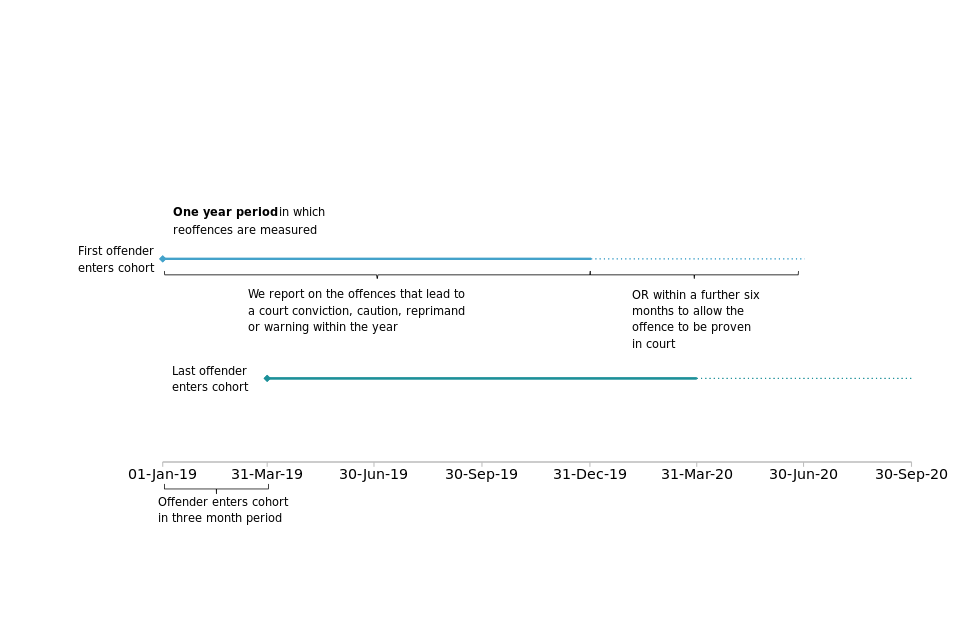
The timeseries presented in this publication spans the April to June 2007 through to the January to March 2019 quarterly offender cohorts. Users should be cautious when making any comparison between cohorts before and after October 2015. This is because there is a change in data source from October 2015 onwards. In addition, users should be cautious when comparing the 3-monthly cohorts to one another (e.g. October to December 2018 to July to September 2018). This is due to the smaller 3-month cohort size the measure is likely to be more variable than the previous 12-month cohort measure of reoffending. For further details on this, and how proven reoffending is measured, please see the guide to proven reoffending statistics and How the measure of proven reoffending has changed and the effect of these changes.
2. Overall – adult and juvenile offenders
The overall proven reoffending rate was 26.7% for the January to March 2019 offender cohort.
This represents a decrease of 2.1 percentage points from the same quarter in 2018. Over time, the overall proven reoffending rate has fluctuated between 26.7% and 31.8%.
Proven reoffences are measured over a one-year follow-up period and a further six-month waiting period to allow for offences to be proven in court. For the January to March 2019 offender cohort, the waiting period coincided firmly with the operational restrictions following the response to the COVID-19 pandemic. As a result, we have started to see an effect on proven reoffending as limits on criminal court activity over this period meant a reduction in the volumes of cases processed and an increase in outstanding cases in Magistrates’ and Crown Courts.
The overall proven reoffending rate, based on just under 101,000 adult and juvenile offenders (made up of 94% adults and 6% juveniles) [footnote 2] in the January to March cohort was 26.7%, a 2.1 percentage point decrease from the same quarter in 2018; it was also the largest year-on-year decrease since the same quarter in 2008 and the lowest rate in the timeseries. Almost 27,000 of these offenders then committed just over 104,000 proven reoffences over a one-year follow-up period, equivalent to an average of 3.89 reoffences each. Whilst the average number of reoffences per reoffender (also known as the frequency rate) had broadly increased from 3.14 in the same quarter in 2009, the latest figure of 3.89 represents a decrease compared to the same quarter in 2018.
Figure 1: Proportion of adult and juvenile offenders in England and Wales who commit a proven reoffence and the number of offenders in each cohort, April 2007 to March 2019 (Source: Table A1)
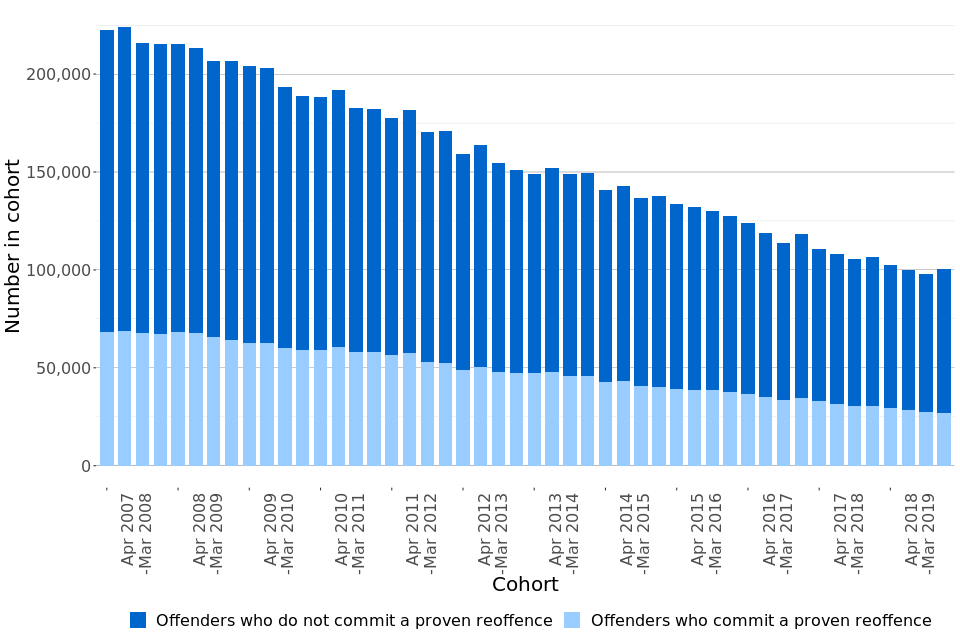
Of this latest offender cohort, 84% were male and 16% were female, with the gender split remaining reasonably stable over time. Male offenders reoffended at a higher rate of 27.6% compared to female offenders who reoffended at a rate of 21.7%. Since 2007, these rates have fluctuated between 27.6% and 33.9% for males and 21.5% to 24.4% for females.
3. Adult offenders
Adult offenders had a proven reoffending rate of 26.1%.
This is a decrease of 1.9 percentage points since the same quarter in 2018, representing the largest year-on-year decrease and the lowest rate in the timeseries. The rate has fluctuated between approximately 26.1% and 30.6% over time.
Since 2007, the adult reoffending rate has remained broadly flat, with only small fluctuations over time. However, the latest figure shows a rate of 26.1% amongst the January to March 2019 cohort which is a decrease of 1.9 percentage points since the same quarter in 2018. This represents the largest year-on-year decrease since the same quarter in 2008. It is also the lowest reoffending rate in the timeseries and likely due to the effect of the operational restrictions put in place as a result of the COVID19 pandemic, and hence limited criminal court activity.
Just over 96,000 proven reoffences were committed over the one-year follow-up period by almost 25,000 adults. Those that reoffended committed on average 3.89 reoffences, a decrease from 4.02 reoffences in the same quarter in 2018. Whereas the trend in more recent years has indicated that a smaller number of reoffenders have been committing a higher number of reoffences, this latest figure represents a level not seen since 2016 and suggests that the operational consequences of the pandemic may also be affecting the frequency rate.
Figure 2: Proportion of adult offenders in England and Wales who commit a proven reoffence, by number of previous offences, January to March 2019 (Source: Table A5a)
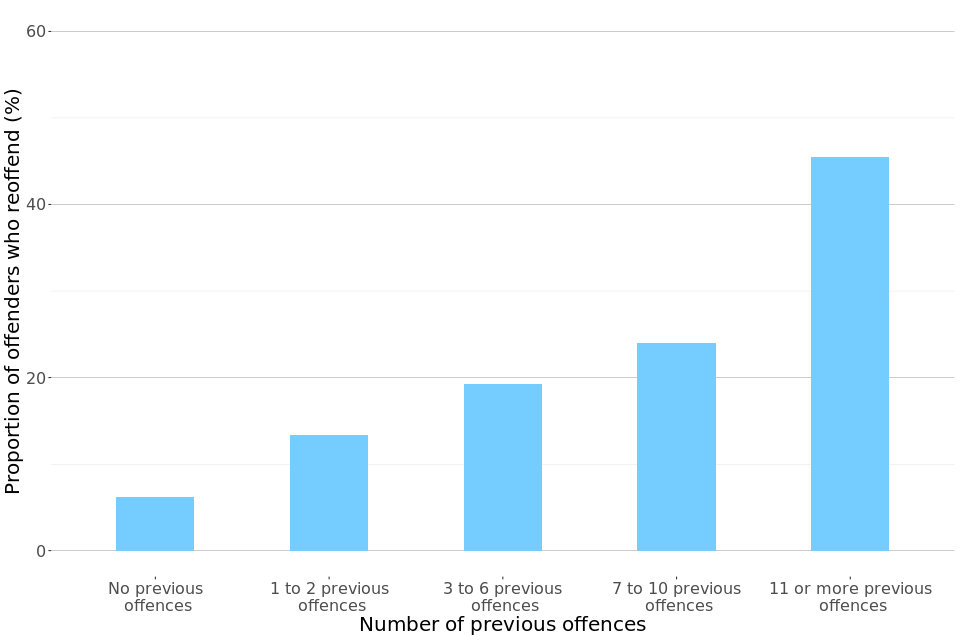
Offenders with a larger number of previous offences have a higher rate of proven reoffending than those with fewer previous offences. Adult offenders with 11 or more previous offences made up 39% of all adult offenders in the cohort, represented 69% of all adult reoffenders and committed 79% of all adult proven reoffences. They also had a higher proven reoffending rate and frequency rate compared to those with fewer previous offences.
In the January to March 2019 cohort, the proven reoffending rates for adults ranged from 6.2% for offenders with no previous offences to 45.4% for offenders with 11 or more previous offences (figure 2), whilst 2.19 reoffences per reoffender were committed by those with no previous offences compared to 4.49 for offenders with 11 or more previous offences.
4. Adjusted reoffending rates
When controlling for offender characteristics, 26.8% of adult offenders in the cohort reoffended within a year.
This represents a decrease of 1.2 percentage points compared to the same quarter in 2018 and the lowest adjusted rate in the timeseries.
The raw proven reoffending rates have been adjusted against the 2011 calendar year, in line with the Payment by Results (PbR) statistics.[footnote 3] These adjusted rates for adults are calculated by ‘the proportion of offenders who reoffend’ (proven reoffending rate) for the cohort plus any difference between the average Offender Group Reconviction Scale (OGRS4/G) score in that cohort and the 2011 cohorts.[footnote 4]
Figure 3: The proportion of offenders who reoffend, the average OGRS scores and the adjusted proven reoffending rate for adults, April 2007 to March 2019 (Source: Table A1)
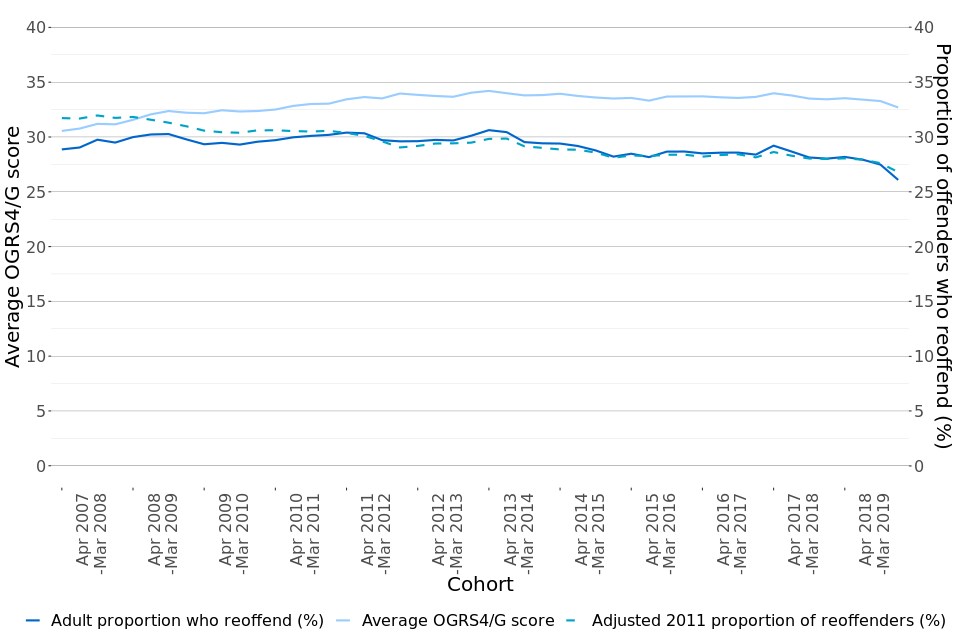
Between 2006 and 2011 the average OGRS score increased, but since 2011 it has remained relatively flat. This indicates that between 2006 and 2011 the cohort had an increasing propensity to reoffend, but since 2011 this has levelled off. As a result, the raw reoffending rates for adults are adjusted upwards between 2006 and 2011 reflecting the lower propensity to reoffend when compared to later cohorts.
Following 2011 the raw rates and the adjusted rates have tracked each other more closely. For example, the raw reoffending rate for adults for the January to March 2019 period was 26.1% while the adjusted rate was 26.8%.
5. Juvenile offenders[footnote 5]
Juvenile offenders had a proven reoffending rate of 36.4%.
The juvenile reoffending rate decreased by 2.8 percentage points from the same quarter in the previous year and, over the years, has fluctuated between 36.3% and 43.6%.[footnote 6] However, for context, the number of offenders in the cohort has fallen by 88% since the same quarter in 2008.
The juvenile reoffending rate was 36.4%, a 2.8 percentage point decrease from the same quarter in the previous year, and the lowest rate seen since 2009. Of the approximately 6,000 juvenile offenders in the January to March 2019 cohort, just over 2,000 of them committed a reoffence within a one-year follow-up period (equivalent to around 8,000 proven reoffences). However, the number of offenders in the cohort has fallen by 88% since the same quarter in 2008, creating more volatility in the series, i.e. with the rate fluctuating between 36.3% and 43.6% over the years.
Those that reoffended committed on average 3.87 reoffences each. As with the adult cohort, juvenile offenders with 11 or more previous offences had a higher reoffending rate than those with no previous offences, 71.8% and 18.7% respectively.
Figure 4: Proportion of adult and juvenile offenders in England and Wales who commit a proven reoffence, by age, January to March 2019 (Source: Table A3)
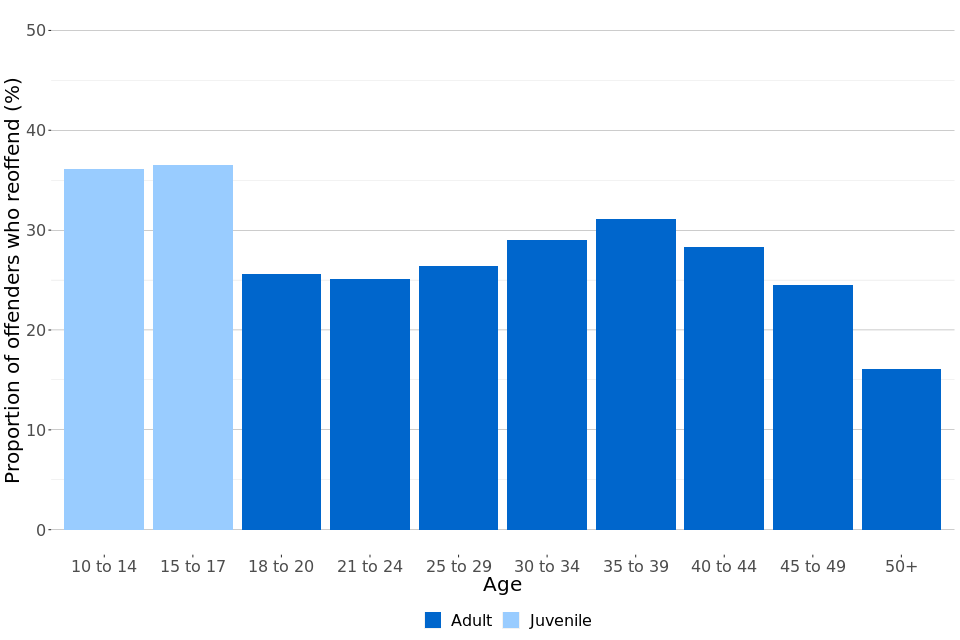
This quarter, 15 to 17-year-old offenders have the highest reoffending rate, closely followed by the 10 to 14-year-old offenders, with reoffending rates of 36.5% and 36.2% respectively (figure 4). The proven reoffending rate for juveniles is higher than adults and the rate starts to fall with increasing age after the 35 to 39-year-old group.
6. Adult reoffending by disposal[footnote 7]
Adults released from custody or starting court orders had a proven reoffending rate of 33.8%.
This represents a 2.9 percentage point decrease since the same quarter in 2018 and a 6.2 percentage point decrease since the same quarter in 2011.
Adults released from custodial sentences of less than 12 months had a proven reoffending rate of 59.9%.
This is a decrease of 2.8 percentage points from the same quarter in the previous year. Those released from sentences of less than or equal to 6 months had a proven reoffending rate of 62.1%, which is also a decrease of 2.7 percentage points since the same quarter in the previous year.
Adults released from custody or starting court orders had a proven reoffending rate of 33.8%, a decrease of 2.9 percentage points compared to the same quarter in 2018 and a decrease of 6.2 percentage points since the same quarter in 2011, i.e. the year for which the PbR baseline was originally constructed. Mirroring the adult reoffending rates generally, this latest figure is the lowest in the timeseries and likely to reflect the effect of the operational restrictions as a result of the COVID-19 pandemic.
The proven reoffending rate for adult offenders starting a court order[footnote 8] specifically was 30.1%, representing decreases of 2.4 and 6.4 percentage points compared to the same quarters in 2018 and 2011 respectively. When adjusted for offender mix (i.e. when controlling for offender characteristics), the decrease observed since 2011 is smaller at 2.8 percentage points.
Figure 5: Proportion of adult offenders released from custody who commit a proven reoffence, by custodial sentence length, April 2007 to March 2019 (Source: Table C2a)
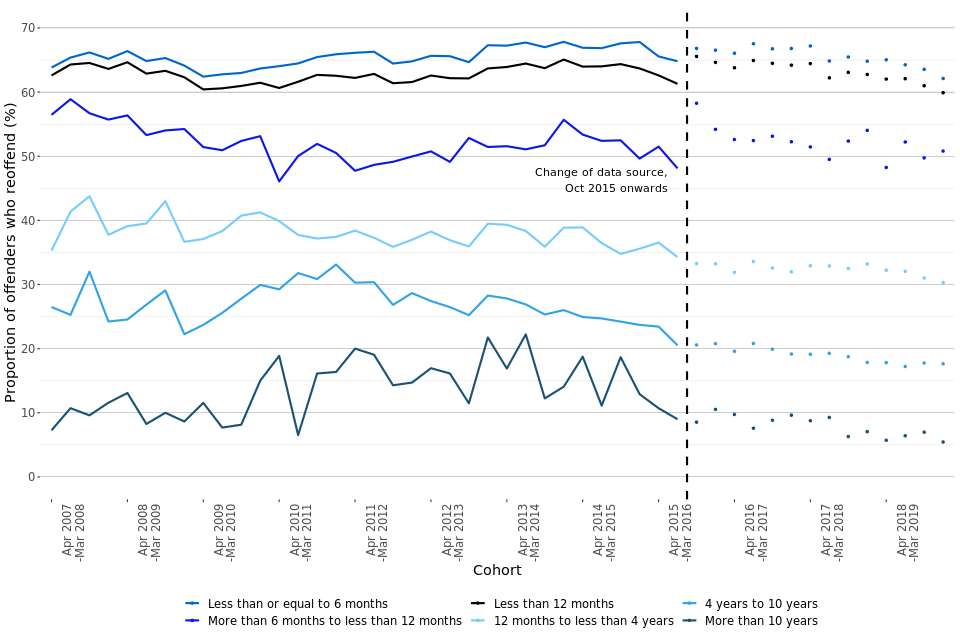
The proven reoffending rate for adult offenders released from custody was 43.6%, a 3.2 percentage point decrease compared to the same quarter in 2018. However, adults who served sentences of 12 months or more reoffended at a substantially lower rate at 26.3% compared to those who served a sentence of less than 12 months at a rate of 59.9%. Those released from sentences of less than or equal to 6 months had a proven reoffending rate of 62.1%, a decrease of 2.7 percentage points since the same quarter in the previous year. Users should exercise caution when comparing the effectiveness of different sentences because the presented rates do not control for known differences in offender characteristics receiving those sentences - for further information please consult recent research on the impact of short custodial sentences, community orders and suspended sentence orders on reoffending as well as the guide to proven reoffending statistics.[footnote 9]
7. Juvenile reoffending by disposal[footnote 10]
Juvenile offenders given youth cautions had a proven reoffending rate of 24.4%.
The reoffending rate for juvenile offenders given youth cautions has decreased by 2.4 percentage points since the same quarter last year.
Reprimands and warnings for youths were abolished under the Legal Aid Sentencing and Punishment of Offenders Act 2012 with effect from 8 April 2013 and replaced with youth cautions. Youth cautions are a formal out-of-court disposal that can be used as an alternative to prosecution for juvenile offenders in certain circumstances. A youth caution may be given for any offence where the young offender admits an offence and there is sufficient evidence for a realistic prospect of conviction, but it is not in the public interest to prosecute.
Figure 6: Proportion of juvenile offenders released from custody or given a reprimand, warning or caution who commit a proven reoffence, April 2007 to March 2019 (Source: Table C1b)
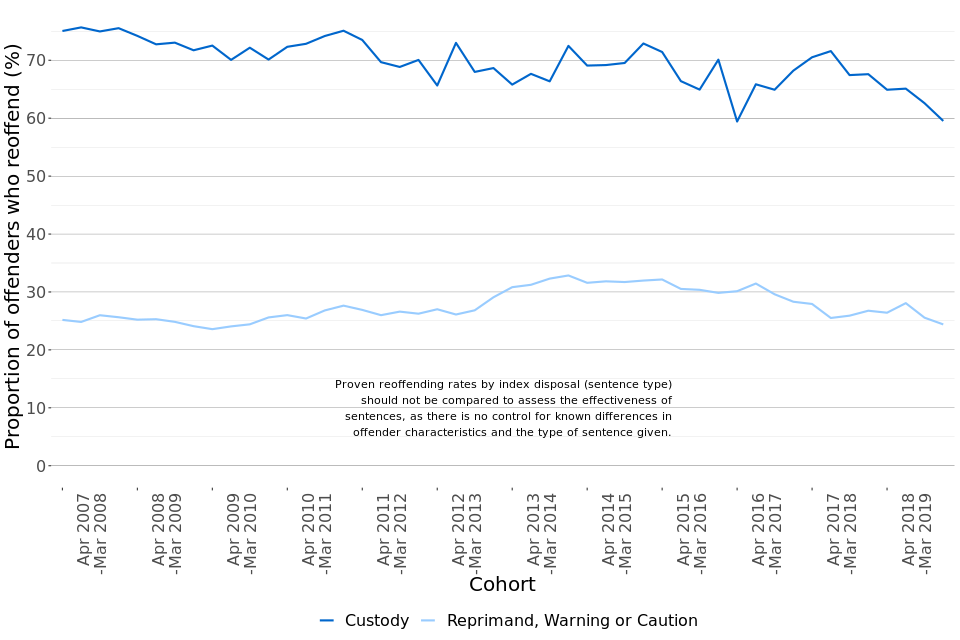
Between January to March 2019, 126 juvenile offenders were released from custody and 75 (59.5%) were proven to have committed a reoffence within a year. The rate has decreased by 8.1 percentage points since the same quarter in 2018. Although this more marked decrease is likely to be partly due to the operational restrictions during the pandemic, there is inherently more variation with the new reoffending measure from one quarter to another due to the reduced size of the juvenile cohort.
8. Index offences[footnote 11]
For the January to March 2019 adult cohort, the index offence category associated with the highest reoffending rate was theft at 49.9%, reflecting the general trend observed across the timeseries
The second highest reoffending rate of 35.0% amongst adult offenders was those with an index offence of public order (figure 7).
Figure 7: Proportion of adult and juvenile offenders in England and Wales who commit a proven reoffence, by index offence (except the ‘other’ offence category), January to March 2019 (Source: Table A4a/b)
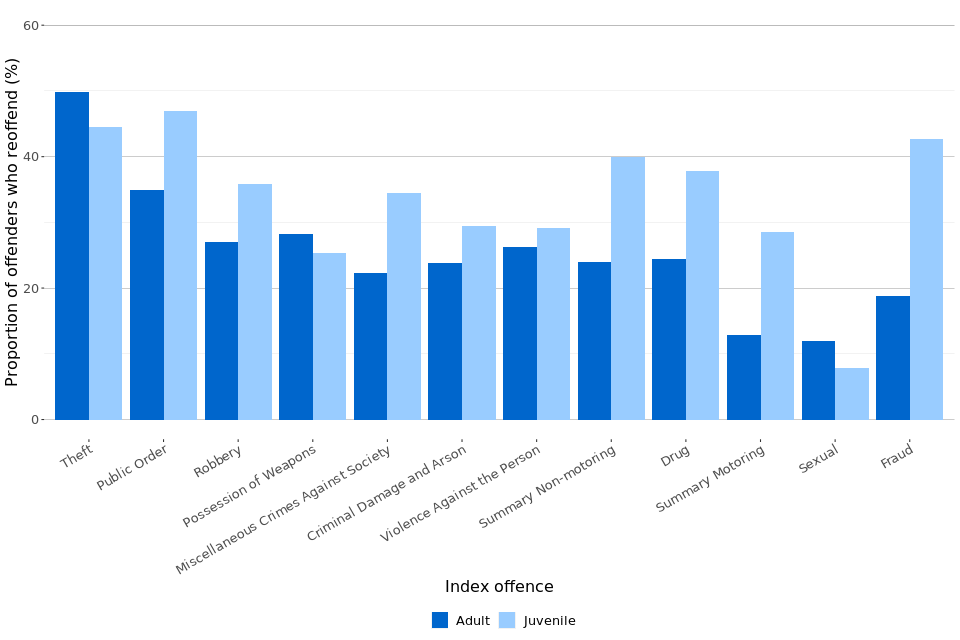
The proportion of reoffences committed depending on index offence has remained broadly stable over time. The lowest rate of reoffending in the adult cohort was observed amongst those with a sexual offence as their index offence, with a rate of 12.0%. Excluding the ‘other’ offence category, the miscellaneous crimes against society index offence category saw the largest percentage point decrease in reoffending rate since the same quarter in 2008, a 14.5 percentage point difference. Those with an index offence of violence against a person or fraud saw the biggest increase in this period, a 5.3 percentage point difference for each.
In the juvenile cohort, those with an index offence of public order had the highest proven reoffending rate at 46.9%, followed by those with an index offence of theft at 44.5%. Those with the lowest rate, excluding the ‘other’ offence category, were offenders who had committed a sexual index offence. Their reoffending rate was 7.9%. Those who committed miscellaneous crimes against society index offences saw the largest percentage point decrease in reoffending rate since the same quarter in 2008 (a 10.9 percentage point difference) whilst fraud index offences represented the biggest percentage point increase over the same period (a 16.0 percentage point difference).
8.1 Further information
Accompanying files
As well as this bulletin, the following products are published as part of this release:
- A technical guide to proven reoffending statistics providing information on how proven reoffending is measured and the data sources used.
- A set of overview tables, covering each section of this bulletin.
- A set of data tools covering proven reoffending data by demographics, offender history, individual prisons (available from April 2005 - September 2015), probation area and geography.
National Statistics status
National Statistics status means that official statistics meet the highest standards of trustworthiness, quality and public value. All official statistics should comply with all aspects of the Code of Practice for Official Statistics. They are awarded National Statistics status following an assessment by the Authority’s regulatory arm. The Authority considers whether the statistics meet the highest standards of Code compliance, including the value they add to public decisions and debate.
It is the Ministry of Justice’s responsibility to maintain compliance with the standards expected for National Statistics. If we become concerned about whether these statistics are still meeting the appropriate standards, we will discuss any concerns with the Authority promptly. National Statistics status can be removed at any point when the highest standards are not maintained, and reinstated when standards are restored.
Future publications
Our statisticians regularly review the content of publications. Development of new and improved statistical outputs is usually dependent on reallocating existing resources. As part of our continual review and prioritisation, we welcome user feedback on existing outputs including content, breadth, frequency and methodology. Please send any comments you have on this publication including suggestions for further developments or reductions in content.
Contact
Press enquiries should be directed to the Ministry of Justice press office:
Tel: 020 3334 3536
Email: newsdesk@justice.gsi.gov.uk
Other enquiries and feedback on these statistics should be directed to the Data and Evidence as a Service division of the Ministry of Justice:
Liz Whiting, Head of Reducing Reoffending and Probation Statistics
Ministry of Justice, 7th Floor, 102 Petty France, London, SW1H 9AJ
Email: ESD@justice.gov.uk
Next update: 29 July 2021
URL: www.gov.uk/government/collections/proven-reoffending-statistics
© Crown copyright
Produced by the Ministry of Justice
Alternative formats are available on request from ESD@justice.gov.uk
-
For the latest figures on criminal court statistics, please refer to https://www.gov.uk/government/statistics/criminal-court-statistics-quarterly-october-to-december-2020 ↩
-
A certain proportion of offenders who could not be matched to the Police National Computer (PNC) are excluded from the offender cohort. Therefore, this number does not represent all proven offenders. This means that the number of offenders in this bulletin will be different from the numbers published in Offender Management Statistics Quarterly and Criminal Justice Statistics. Please refer to the guide to proven reoffending statistics for further information. ↩
-
Refer to Payment by results statistics for proven reoffending statistics for adult offenders being managed by Community Rehabilitation Companies, under PbR arrangements, and by the National Probation Service. ↩
-
OGRS4 is based on a well-established, peer reviewed methodology for assessing and representing reoffending risk. Refer to A compendium of research and analysis on the Offender Assessment System (OASys) for details. ↩
-
Juveniles are defined as those aged 10 to 17 years old. ↩
-
The new reoffending measure, however, is likely to be more variable from quarter to quarter due to the smaller size of the cohorts. ↩
-
For proven reoffending statistics, a disposal is defined as a caution, court order, custody, or other disposal resulting from a conviction at court, such as a fine or discharge. A different methodology is used for proven reoffending statistics by disposal type. The first proven offence within each disposal is treated as the start point for measuring proven reoffending. Therefore, some offenders will appear in more than one disposal category. ↩
-
Community order or suspended sentence order. ↩
-
Proven reoffending rates by disposal should not be compared to assess the effectiveness of sentences, as there is no control for known differences in offender characteristics and the type of sentence given. For further information see Annex D of the October 2016 publication (page 41) and the guide to proven reoffending statistics. ↩
-
The juvenile proven reoffending data by disposal uses the same methodology as that adopted for adult reoffending by disposal (see section 5 for more details). ↩
-
An index offence refers to the offence that leads to an offender being included in the offender cohort. ↩
